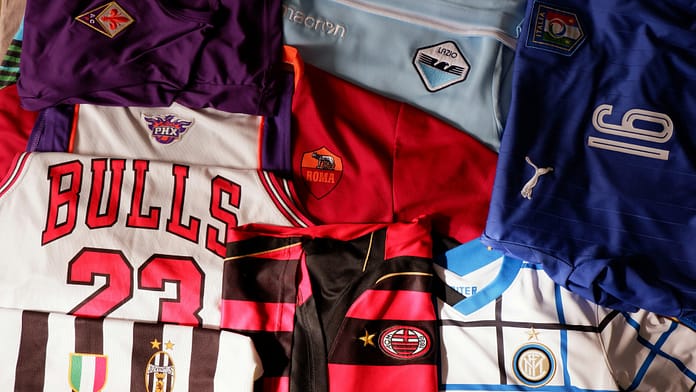From the streets of London to Los Angeles, football jerseys have evolved from stadium essentials to full-on fashion statements. What was once just a symbol of club loyalty is now a canvas for self-expression; mixing heritage, nostalgia, and bold design. With the World Cup at bay in just 12 months in the United States, this evolution isn’t just reshaping fan identity; it’s transforming the finance of football and brand marketing within the game.
At the core of this transformation is the way football kits have moved beyond the pitch to become lifestyle garments. Retro shirts from the ‘90s have made a massive comeback, becoming streetwear staples worn worldwide. The Nike T90 template, the Arsenal bruised banana strip, and Nigeria’s iconic 2018 zig-zag design aren’t just fan favorites—they’re cultural artifacts that resonate across generations. Fans no longer just wait for matchday to wear their team’s colors. Kits are now styled with denim, layered under bomber jackets, or paired with sneakers and jewelry, creating a new visual language around football culture; and as the World Cup approaches U.S. soil, brands and clubs alike are doubling down on this moment, blending sport and style to captivate both traditional fans and fashion-savvy newcomers.
Global brands like Adidas have leaned into this shift, helping define the intersection between fashion and football. In 2024, instead of limiting special collections to their “Elite” clubs, Adidas released retro heritage lines that celebrated the histories of a broader range of teams—from Arsenal and Bayern to AS Roma and Ajax. These collections revived iconic designs from the ‘70s, ‘80s, and ‘90s, reintroducing the Trefoil logo and classic crests with modern silhouettes and fabrics. Additionally, cross collaborations have brought fresh energy into the kit space. Adidas’ 2023/24 collaboration with Manchester United and Manchester-based music legends The Stone Roses captured Manchester’s deep cultural identity, blurring the lines between football, music, and fashion. These projects not only tap into nostalgia but also tell richer stories that appeal to a global, style-conscious audience.
This storytelling has become a key pillar in the commercial strategy of top clubs. Jersey drops are now timed like fashion collections—complete with cinematic launch videos, influencer rollouts, and exclusive retail partnerships with platforms like END. and KITH. From pre-match gear to training collections and one-off anniversary kits, clubs are building full wardrobes around their brands. These releases cater especially to Gen Z, who value design, identity, and exclusivity in what they wear; and as clubs lean into fashion-forward marketing, the impact is clear: revenue from merchandise is soaring, global visibility is growing, and club branding is evolving from team apparel into lifestyle expression.
More importantly, this fashion-first approach is helping clubs break into non-traditional football markets. From North America to parts of Asia and Africa, teams are using kits, collaborations, and cultural partnerships to attract younger fans who may not follow match results, but follow style, music, and creators. PSG’s alignment with Jordan, Inter Milan’s work with Moncler, and Arsenal’s partnership with Stella McCartney show how clubs are embedding themselves in new cultural spaces. In doing so, they are no longer just selling kits—they’re selling belonging, identity, and aspiration. As the line between streetwear and sportswear continues to blur, football clubs are positioning themselves not only as competitors on the field but as globally relevant brands redefining what fandom and sports marketing looks like in the 21st century.
This shift is particularly crucial in the U.S., where football, still building its cultural foothold, has found a surprising entry point through fashion. For many younger Americans, the football shirt isn’t about the 90 minutes on the pitch; it’s about an aesthetic, storytelling, and a global connection. As MLS clubs begin to launch bolder designs and European giants increase their investment in U.S. retail activations and influencer marketing, kits are becoming the most visible, and wearable, form of football fandom and marketing. In a country where streetwear culture drives entire economies, the jersey has emerged as a marketing bridge: an accessible product that introduces the sport to new audiences without requiring them to know league tables or follow any sort of transfer news. With the World Cup on the horizon, this fashion-first strategy is converting casual consumers into emotionally invested fans; and unlocking fresh revenue streams in the process.
Driving this cultural and commercial shift are platforms like Classic Football Shirts, which have turned retro kits into coveted fashion items and storytelling devices. Started by Matthew Dale, Gary, and Doug Bierton from their dorm room at the University of Manchester, their brand has seen them expand to having three flagship stores in major U.S. markets (Los Angeles, New York, Miami.) Their curated drops, pop-up events, and collaborations with creators have made vintage kits not only accessible but aspirational both digitally and in-person. Content creators like Ellis Platten have amplified this movement, using social media to showcase the emotional value and cultural relevance of historic shirts, blending fan knowledge with modern aesthetics, and matchday vlogs. By treating kits as both collectible artifacts and wearable art, CFS and voices like Ellis are helping reframe football apparel for a generation less focused on matchday tradition and more attuned to identity, fashion, and individuality. In doing so, they’re not just preserving football history: they’re marketing it to the future.
The rise of football fashion isn’t just a trend—it’s a transformation. What began as simple sportswear has become a powerful tool for storytelling, identity, and market expansion. From legacy clubs leveraging nostalgia to creators turning kits into cultural currency, the modern football jersey now lives far beyond the pitch. As the 2026 World Cup approaches, especially in a market as style-driven and culturally fragmented as the U.S., this fusion of football and fashion offers a once-in-a-generation opportunity. Clubs, brands, and creatives that understand this moment aren’t just selling shirts, they’re shaping how the next generation connects with the game.

